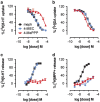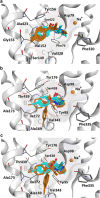'Second-generation' mephedrone analogs, 4-MEC and 4-MePPP, differentially affect monoamine transporter function
- PMID: 25502630
- PMCID: PMC4397398
- DOI: 10.1038/npp.2014.325
'Second-generation' mephedrone analogs, 4-MEC and 4-MePPP, differentially affect monoamine transporter function
Abstract
The nonmedical use of synthetic cathinones is increasing on a global scale. 4-Methyl-N-methylcathinone (mephedrone) is a popular synthetic cathinone that is now illegal in the United States and other countries. Since the legislative ban on mephedrone, a number of 'second-generation' analogs have appeared in the street drug marketplace, including 4-methyl-N-ethylcathinone (4-MEC) and 4'-methyl-α-pyrrolidinopropiophenone (4-MePPP). Here we characterized the interactions of 4-MEC and 4-MePPP with transporters for 5-HT (SERT) and dopamine (DAT) using molecular, cellular, and whole-animal methods. In vitro transporter assays revealed that 4-MEC displays unusual 'hybrid' activity as a SERT substrate (ie, 5-HT releaser) and DAT blocker, whereas 4-MePPP is a blocker at both transporters but more potent at DAT. In vivo microdialysis experiments in rat brain demonstrated that 4-MEC (1-3 mg/kg, i.v.) produced large increases in extracellular 5-HT, small increases in dopamine, and minimal motor stimulation. In contrast, 4-MePPP (1-3 mg/kg, i.v.) produced selective increases in dopamine and robust motor stimulation. Consistent with its activity as a SERT substrate, 4-MEC evoked inward current in SERT-expressing Xenopus oocytes, whereas 4-MePPP was inactive in this regard. To examine drug-transporter interactions at the molecular level, we modeled the fit of 4-MEC and 4-MePPP into the binding pockets for DAT and SERT. Subtle distinctions in ligand-transporter binding were found that account for the differential effects of 4-MEC and 4-MePPP at SERT. Collectively, our results provide key information about the pharmacology of newly emerging mephedrone analogs, and give clues to structural requirements that govern drug selectivity at DAT vs SERT.
Figures






References
Publication types
MeSH terms
Substances
Grants and funding
LinkOut - more resources
Full Text Sources
Other Literature Sources

